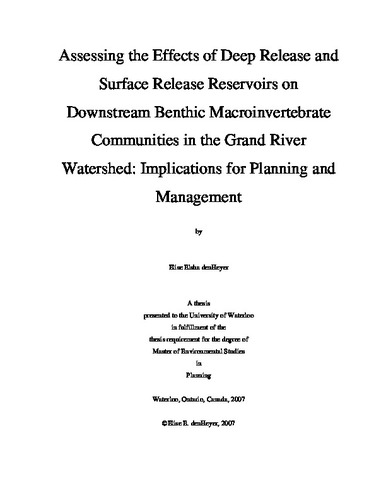| dc.description.abstract | River regulation and reservoirs can provide a variety of services including flood protection, flow management and flow augmentation, however, there is increasing concern regarding these effects on downstream lotic environments and aquatic ecosystems. While a growing body of knowledge regarding the ecological effects of regulation exists, little is still known about the effects of reservoirs and their management strategies on benthic macroinvertebrates in the Grand River watershed and further research is needed for sufficient watershed planning and reservoirs management practices. In this study, the downstream effects of river regulation and reservoir on aquatic ecosystems were evaluated using benthic macroinvertebrate biomonitoring techniques.
Field research was conducted on five reservoirs (three deep release and two surface release) located within the Grand River watershed during three sampling periods in May-June, August and November, 2006. Benthic macroinvertebrates were collected using a T-sampler in reaches upstream and downstream of each reservoir across stream riffles perpendicular to stream flow direction. Changes in benthic macroinvertebrate community structure were quantified using nine summary indices. Downstream of reservoirs, invertebrate abundance, Hilsenhoff’s Biotic Index (HBI) values and Isopoda and Chironomidae abundance increased, while taxa richness, Ephemeroptera, Plecoptera and Trichoptera (EPT) taxa and Ephemeroptera abundance decreased. Although comprehensive chemical testing was not conducted in the present study, changes in benthic macroinvertebrate abundance and diversity and a review of literature suggests that downstream ecosystems may have been impacted by changes in water quality, thermal alterations and modifications to habitat diversity induced by impoundments and most noticeably deep release reservoir designs.
Benthic macroinvertebrates are useful biological indicators and monitoring tools to assess the effects of reservoirs and their management strategies on downstream ecosystems. Information gained from this study may assist policymakers and planners in monitoring, developing and implementing improved watershed planning and reservoir management decision making. | en |

